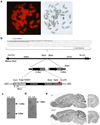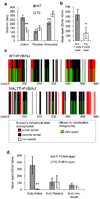Multiple autism-like behaviors in a novel transgenic mouse model
- PMID: 21093492
- PMCID: PMC3022332
- DOI: 10.1016/j.bbr.2010.11.026
Multiple autism-like behaviors in a novel transgenic mouse model
Abstract
Autism spectrum disorder (ASD) diagnoses are behaviorally based with no defined universal biomarkers, occur at a 1:110 ratio in the population, and predominantly affect males compared to females at approximately a 4:1 ratio. One approach to investigate and identify causes of ASD is to use organisms that display abnormal behavioral responses that model ASD-related impairments. This study describes a novel transgenic mouse, MALTT, which was generated using a forward genetics approach. It was determined that the transgene integrated within a non-coding region on the X chromosome. The MALTT line exhibited a complete repertoire of ASD-like behavioral deficits in all three domains required for an ASD diagnosis: reciprocal social interaction, communication, and repetitive or inflexible behaviors. Specifically, MALTT male mice showed deficits in social interaction and interest, abnormalities in pup and juvenile ultrasonic vocalization communications, and exhibited a repetitive stereotypy. Abnormalities were also observed in the domain of sensory function, a secondary phenotype prevalently associated with ASD. Mapping and expression studies suggested that the Fam46 gene family may be linked to the observed ASD-related behaviors. The MALTT line provides a unique genetic model for examining the underlying biological mechanisms involved in ASD-related behaviors.
Copyright © 2010 Elsevier B.V. All rights reserved.
Figures









Similar articles
-
Development of an autism severity score for mice using Nlgn4 null mutants as a construct-valid model of heritable monogenic autism.Behav Brain Res. 2013 Aug 15;251:41-9. doi: 10.1016/j.bbr.2012.11.016. Epub 2012 Nov 23. Behav Brain Res. 2013. PMID: 23183221
-
NEXMIF/KIDLIA Knock-out Mouse Demonstrates Autism-Like Behaviors, Memory Deficits, and Impairments in Synapse Formation and Function.J Neurosci. 2020 Jan 2;40(1):237-254. doi: 10.1523/JNEUROSCI.0222-19.2019. Epub 2019 Nov 8. J Neurosci. 2020. PMID: 31704787 Free PMC article.
-
Replicable in vivo physiological and behavioral phenotypes of the Shank3B null mutant mouse model of autism.Mol Autism. 2017 Jun 15;8:26. doi: 10.1186/s13229-017-0142-z. eCollection 2017. Mol Autism. 2017. PMID: 28638591 Free PMC article.
-
Behavioral neuroscience of autism.Neurosci Biobehav Rev. 2020 Mar;110:60-76. doi: 10.1016/j.neubiorev.2019.04.012. Epub 2019 May 3. Neurosci Biobehav Rev. 2020. PMID: 31059731 Review.
-
Mouse behavioral assays relevant to the symptoms of autism.Brain Pathol. 2007 Oct;17(4):448-59. doi: 10.1111/j.1750-3639.2007.00096.x. Brain Pathol. 2007. PMID: 17919130 Free PMC article. Review.
Cited by
-
Functions and mechanisms of RNA tailing by metazoan terminal nucleotidyltransferases.Wiley Interdiscip Rev RNA. 2021 Mar;12(2):e1622. doi: 10.1002/wrna.1622. Epub 2020 Jul 22. Wiley Interdiscip Rev RNA. 2021. PMID: 33145994 Free PMC article. Review.
-
FAM46 proteins are novel eukaryotic non-canonical poly(A) polymerases.Nucleic Acids Res. 2016 May 5;44(8):3534-48. doi: 10.1093/nar/gkw222. Epub 2016 Apr 7. Nucleic Acids Res. 2016. PMID: 27060136 Free PMC article.
-
Development of home cage social behaviors in BALB/cJ vs. C57BL/6J mice.Behav Brain Res. 2013 Jan 15;237:338-47. doi: 10.1016/j.bbr.2012.08.051. Epub 2012 Sep 5. Behav Brain Res. 2013. PMID: 22982070 Free PMC article.
-
The complexity of ventral CA1 and its multiple functionalities.Genes Brain Behav. 2022 Sep;21(7):e12826. doi: 10.1111/gbb.12826. Epub 2022 Jul 11. Genes Brain Behav. 2022. PMID: 35815710 Free PMC article. Review.
-
Translational relevance of forward genetic screens in animal models for the study of psychiatric disease.Neurosci Biobehav Rev. 2022 Apr;135:104559. doi: 10.1016/j.neubiorev.2022.104559. Epub 2022 Feb 4. Neurosci Biobehav Rev. 2022. PMID: 35124155 Free PMC article. Review.
References
-
- CDC. MMWR Surveill Summ. Vol. 58. 2009. Prevalence of autism spectrum disorders - Autism and Developmental Disabilities Monitoring Network, United States, 2006; pp. 1–20. - PubMed
-
- American Psychiatric Association. Diagnostic and statistical manual of mental disorders : DSM-IV-TR. 4th ed. Washington, DC: American Psychiatric Association; 2000. American Psychiatric Association. Task Force on DSM-IV.
-
- Chess S, Fernandez P, Korn S. Behavioral consequences of congenital rubella. J Pediatr. 1978;93:699–703. - PubMed
-
- Stromland K, Nordin V, Miller M, Akerstrom B, Gillberg C. Autism in thalidomide embryopathy: a population study. Dev Med Child Neurol. 1994;36:351–356. - PubMed
MeSH terms
Grants and funding
LinkOut - more resources
Full Text Sources
Molecular Biology Databases

